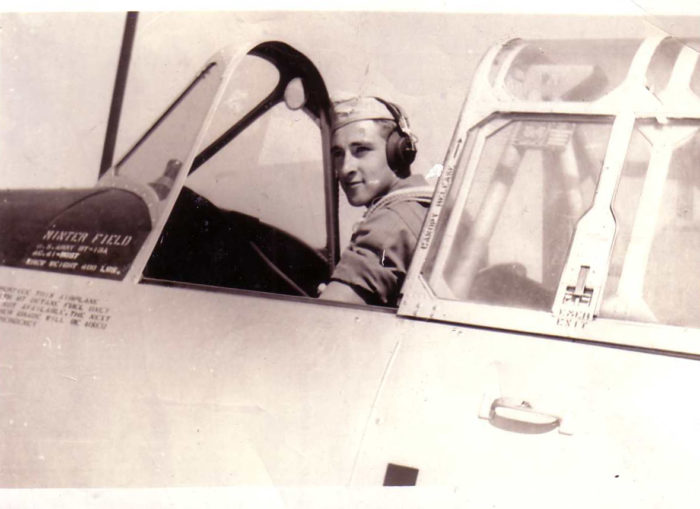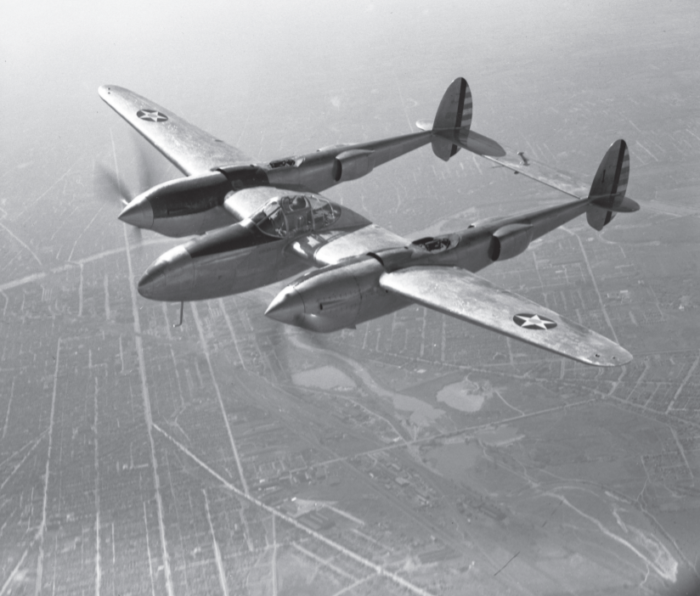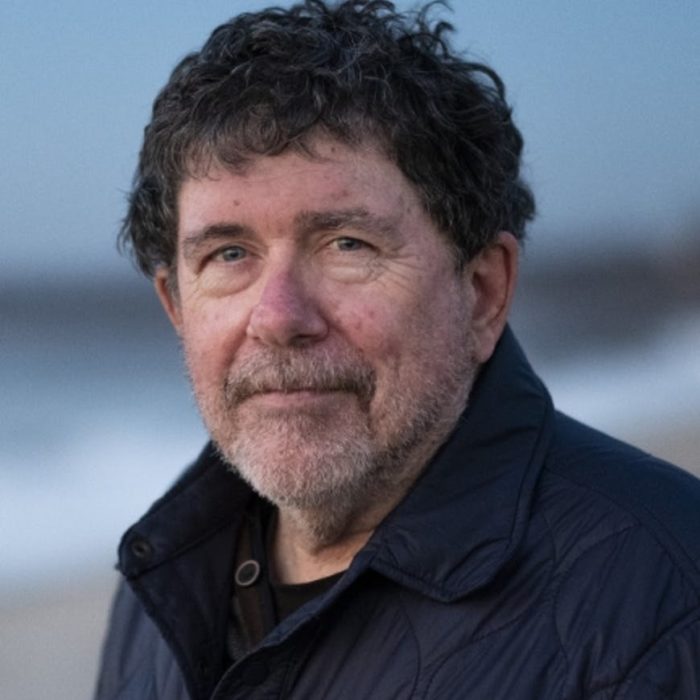by Tom Clavin
Lightning Down by Tom Clavin is the incredible saga of American fighter pilot Joe Moser, who piloted a P-38 Lightning, one of the most effective weapons the Army Air Corps had against the powerful German Luftwaffe. The following excerpt recounts one of Joe’s more memorable escort missions, which left him flying on fumes over the English Channel. Read more below.

Joe Moser to realize his dream of flying a P-38 Lightning. (Courtesy of
the Moser family.)
Though just twenty-two and with only a few weeks of combat experience under his belt, Joe already felt close to being a grizzled veteran: “It didn’t take too long to change from high-strung combat rookies to experienced, professional fighter pilots. It is true that the thrill of sliding those throttles forward and feeling all fourteen hundred and fifty of those horses contained in the twin Allison 12-cylinder engines pulling me into the deep blue never diminished. But neither did the gut-chilling dread of knowing each time we left the ‘comfort’ of our cold, drizzly southern English base, it might be our last time.”
In Fork-Tail Devil, James G. Speight writes that after an initial period of getting used to each other, “Generally, the British welcomed the young Americans, but whenever they went into a pub, some attendee of the evening festivities might be heard to mutter knowingly: ‘There are only three things wrong with the Yanks: they’re overpaid, oversexed, and over here.’”
One of Joe’s more memorable escort missions occurred in mid-May. He and other P-38 pilots were to rendezvous with an array of B-17s that in broad daylight had attacked Berlin. Whatever physical damage the bombers inflicted would be at least equaled by the psychological damage of having Hitler’s capital city punished. The fighters would meet the B-17s over the Baltic Sea east of Denmark and protect them on the way back to their base in England. Especially vulnerable were any stragglers—bombers damaged during the raid and having trouble keeping up with the flotilla. Targeting them, of course, was the easiest way for the German pilots to make sure there would be fewer Flying Fortresses hurting their homeland the next day. It was also an easier way to add to their count of kills.
The American fighter pilots flew east far enough to meet up with the returning B-17s. When over western Denmark, 88-mm anti-aircraft batteries on the ground opened up. Bombers and fighters alike were in the midst of deadly flak—the bombers at twenty thousand feet, the escorts five thousand above them. The American planes scattered to lessen the odds of a hit. When the flak was left behind, the planes would regroup.
That was the plan … but it did not work that way for Joe. He was not only free of flak but of his squadron too. “This was not good,” he thought, “not good.” Joe was alone in the sky, and still within reach of foraging German fighters.
He set a course back to his base at Warmwell, “rubbernecking all the way” for his mates and to spot the enemy, who “would try at every opportunity, as we did, to attack from out of the sun and from above to maximize their speed as they dived down.”
Finally, Joe spotted an American plane. It was a B-17, and as he flew lower and closer, he saw how slow it was flying. Then he noticed two of its engines had been shot out, and there was other damage too. This was the kind of wounded straggler the Germans loved to feast upon. Joe tried to contact it by radio, but when there was no response, he figured the radio was also destroyed. Now, Joe realized, “I had a purpose. Even a single P-38 flying near a crippled bomber was enough to discourage the Luftwaffe from trying to pick off the stricken plane.”
Joe flew figure eights as he stayed above the B-17. This maneuver enabled him to keep the Lightning on pace with the damaged bomber, which could only manage 200 mph, and Joe was at 300 mph. It also enabled him to better scan the surrounding sky for enemy aircraft. Joe had to assume that his presence offered hope to the B-17 crew that they just might live through this.
However, while over the English Channel, it became apparent that the bomber was not going to maintain enough altitude to reach land. But the crew was not going to give up easily. Joe watched as ammunition, machine guns, heavier clothing, and almost anything not nailed down or riveted was thrown out the hatches. And then Joe realized he was in some danger himself—of running out of fuel. The figure eights burned gas faster than straightforward flying. If he remained the lone bomber’s escort, Joe risked either not reaching land himself or, if he did make the coast of England, having to survive an emergency landing in a field. But he couldn’t bear the thought of abandoning the wounded bird. Sometimes, one simply has to hope for the best.
Both planes did reach the far side of the Channel. As they neared London from the north, the B-17 veered right, toward its base. On fumes, Joe passed London by and headed for Warmwell. There could only have been ounces of fuel left when he touched down. As he clambered out of the cockpit, Joe prayed the Flying Fortress crew had made it home.

referred to it as the “fork-tailed devil.” (Courtesy of the Smithsonian
National Air and Space Museum.)
It was not until fifty years later that Joe learned that his prayers had been answered. He was attending a midsummer barbecue at St. Joseph’s Church in Ferndale when he heard a man talking to others about being the waist gunner on a B-17 during World War II. Joe was to learn that the man’s name was Earl Thomas, visiting from nearby Lummi Island.
Thomas was telling his listeners about a particular day in 1944, when his bomber was returning from a long mission over Berlin with two engines shot out. “I thought we were a goner,” he said. Thomas continued, as Joe joined the group: “Suddenly I saw this plane up above and behind us. When I noticed it had the twin tails that only belonged to one of our fighters, the P-38, I can’t tell you what a welcome sight that was. That guy followed us all the way back to England, doing figure-eights behind us all the time so he could stay tucked in behind us. He saved our lives, I’m sure of it.”
Unable to stay silent a moment longer, Joe extended his hand and introduced himself, adding, “I think I was flying that P-38.”
He would write in his memoir, “The joy, gratitude and amazement we felt for each other that day was nothing less than if I had landed behind that bird and had discovered that one of my fellow churchmen from right near my own town had been in that plane that I was protecting all the way over Europe.”
The actions of the entire 429th Squadron that day in accompanying the bombers over eight hundred miles, and much of that over water, were greeted soon after its return by a commendation from the commander of the Ninth Air Force, General “Pete” Quesada: “It is with pleasure that I extend my personal congratulations to you and your pilots. Your splendid work of escorting bombers deep in enemy territory reflects the highest credit upon yourselves and your command. Your organization displayed a high state of training, discipline and sense of responsibility.”
During May, a routine had become well established. When weather permitted, every day was essentially the same for Joe and his mates—be briefed on the mission, prepare themselves, get in their P-38s and take off, and fulfill the mission, whatever the risks and the losses. They sensed the Allied firepower gaining in strength and the balance tipping against the Germans, with perhaps an even greater conflict to come. “During this period of May 1944,” the 429th log explains, “we were building up our striking power to its peak and hitting with maximum intensity.” By this time, the enemy was being hit from the air somewhere virtually every hour that the weather permitted.
As much as their rudimentary accommodations at Warmwell had become home, complete with the taproom, it was a relief when the Americans got to leave the base from time to time. Three-day passes were issued, with the duration of the getaway increasing the more missions a pilot had survived. With the less restrictive passes, some pilots ventured as far as London. They were able to go by train because, despite the efforts of German bombers, most rail lines in the area were intact. Another popular destination was Bournemouth, a resort town featuring a pavilion where “tea dances” were held, allowing the young Yanks to socialize with Englishwomen from the surrounding area.
The escort missions went longer distances, straining the fuel supplies of the P-38s, as more raids included targets deep in Germany as well as in France. One of the longest was a six-hour mission that took Joe and other pilots to Berlin itself, escorting a fleet of B-17s. Because the flak was so heavy as the flotilla neared the target area, the fighters were ordered to break formation and leave the sky to the Flying Fortresses dropping their payloads. The Luftwaffe’s Fw 190s saw this as an opportunity and began an attack. However, they stalled in their tracks when the P-38s reappeared. The bombs were dropped, and the B-17s swung around, heading back to England with their feisty escorts. By this time, most of the P-38 pilots had come to recognize and perhaps make peace with the idiosyncrasies of the Lightning. One was having a game plan for bailing out if necessary … if that was possible. The plane’s unique design, especially the twin booms, posed difficulties pilots did not face in other planes. Of course, when his plane was damaged, a pilot’s first priority was to keep the plane in the air and try to get back to Allied territory rather than risk a crash landing or being taken prisoner by German ground forces. But if the damage involved fire or was otherwise so extensive that adequate speed or altitude could not be maintained, a pilot had to get out and take his chances with a parachute.
In Fork-Tailed Devil, Martin Caidin offers the recollection of Brigadier General Edward Giller about his experiences as an Army Air Corps major and P-38 pilot during World War II: “The consensus was you should bail out at high speed or at very low speed just above stalling. It was intended that you would crawl out of the cockpit and slide from the wing and go out under the boom. At high speed, greater than 350 miles per hour, one would remove the canopy, roll full forward trim, then suddenly turn loose of the wheel and give yourself a kick upwards and thereby go out over the tail boom. Unfortunately, a considerable percentage of people accounted for a number of unsuccessful bailouts.”
In other words, when the time came, the pilot might have to improvise. Some flyers got free of the damaged plane; others did not. During the flight that changed his life, Joe Moser would find himself somewhere in between.
Through the rest of the month, the Ninth Air Force hurled everything it had against German strongholds in France and the homeland, with Joe just one of the hundreds of fighter pilots being protective escorts. On May 19, 495 B-17s struck Berlin, dropping bombs through heavy cloud cover. Over Germany and the Baltic Sea that day, seventy-one enemy aircraft were downed. Two days later, Operation Chattanooga Choo-Choo began, targeting rail lines in Germany, and ninety-one locomotives were reported destroyed. But the highest fighter losses to date were posted, with twenty-seven P-38s, P-47s, and P-51s knocked from the sky.
On the twenty-fifth, 325 heavy bombers attacked German coastal batteries at Fécamp and St.-Valery as well as marshaling yards and airdromes in France and Belgium. A different record was set on May 28: The Army Air Corps sent 1,341 bombers into the air to obliterate oil and rail targets in Germany, and combined the XIIIth and IXth Fighter Command provided 1,224 escort sorties. There was little rest for all the pilots of the Ninth Air Force as momentum built toward the invasion everyone knew would happen soon.
At the very end of May, Joe received his first personal commendation, the Air Medal, for a full month of being a fighter pilot. He had indeed achieved his dream, the one that began as he stood in a farm field outside Ferndale and saw a plane flying overhead. Lying in bed that night at the Warmwell base, no matter how many new dreams he’d had about the future, Joe could not possibly have imagined the nightmare ahead.
Tom Clavin is a #1 New York Times bestselling author and has worked as a newspaper editor, magazine writer, TV and radio commentator, and a reporter for The New York Times. He has received awards from the Society of Professional Journalists, Marine Corps Heritage Foundation, and National Newspaper Association. His books include the bestselling Frontier Lawmen trilogy—Wild Bill, Dodge City, and Tombstone—and Blood and Treasure with Bob Drury. He lives in Sag Harbor, NY.

